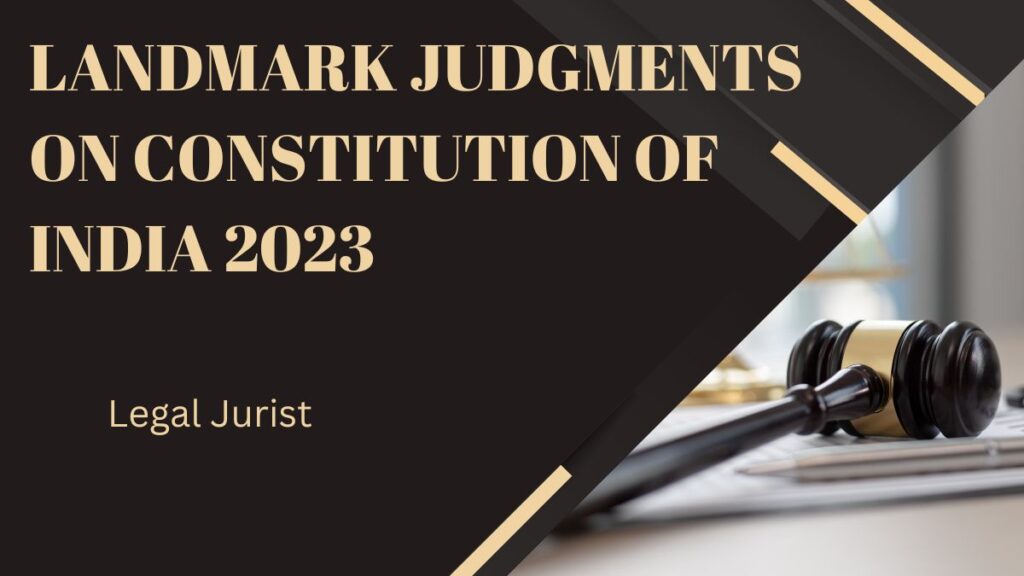Landmark Cases on Constitution of India 2023 | Important Judgments on Constitution of India. When you start preparing for Judiciary Examination, You must have prepared for Important Judgments of Constitution of India and Latest Landmark Judgments of Constitution of India. It is that important because in every Judiciary Exam approx out of 100 marks near about 10 to 15 marks consists of Judgments.

Landmark Cases on Constitution of India
Here is the list of Landmark Judgment of Constitution of India Part 1
Bijoe Emmanuel v State of Kerela1986
Rajbala v State of Haryana 2015
K. Veeraswami v Union of India 1991
Delhi Judicial Service Association v/s State of Gujarat 1991
S.P. Gupta v UOI (First Judges case) 1981
Supreme Court Advocates on Record v UOI (Second Judges case) 1993
In Re Presidential Reference 1998 (Third Judges case)
Supreme Court Advocates on Record v UOI (Fourth Judges case) 2015
Naresh Mirajkar v State of Maharashtra 1966

Romesh Thapar v. State of Madras (1950)
- Freedom of speech and expression includes freedom of propagation of ideas that can only be ensured by circulation.
- The order violates article 19(1)(a).
- The rule of severability was applied to section 9(1-A) of the Madras Maintenance of Public Order Act, 1949.
A. K. Gopalan v. State of Madras (1950)
- Preventive Detention Act, 1950 (exception-section 14) was held valid.
- Section 14 restricted disclosure of the grounds of detention.
- ‘Procedure Established by Law’ does NOT include ‘Due Process of Law’.
Shankari Prasad Singh Deo v. Union of India (1951)
- 1st Constitutional Amendment is valid.
- Constitutional Amendment is not ‘Law’ for Article 13.
- Differences laid down between ‘Ordinary Law’ and ‘Constitutional Amendment.’
The Berubari Union Case (1960)
- Parliament cannot make law under Article 3 to implement the Nehru-Noon agreement.
- The preamble is NOT a part of the Constitution.
- This led to the 9th constitutional Amendment.
Ranjit Udeshi v. State of Maharashtra (1964)
- Section 292 of IPC, which restricted the sale of obscene books, was upheld.
- Hicklin test was applied: does the material deprive and corrupt those whose minds are open to such immoral influences and into whose hands a publication of this sort may fall?
- The Hicklin test was rejected in the 2004 case of Aveek Sarkar v. State of West Bengal.
Golak Nath v State of Punjab 1967
Minerva Mills v UOI 1980
Kesavananda Bharti v. State of Kerala (1973)
- The parliament cannot amend the ‘Basic Structure’.
- Articles 13(4) and 368(3) were valid.
- This led to the passing of the 42nd Amendment and adding Articles 368 (4) & (5).
Balaji Raghavan v UOI 1995
National awards such as Bharat Ratna, Padma Vibhushan, Padma Bhushan and Padma Shri (hereinafter called “The National Awards”) are “Titles” within the meaning of Article 18(1) of the Constitution of India.
Indira Sawhney v Union of India 1993
Ajit Singh v State of Punjab 1999
Also Read Legal Current Affairs for Judiciary Exams
Important Amendments of Constitution of India
E. P. Royappa v. State of Tamilnadu (1973)
- Broadened the concept of equality.
- Equality is a dynamic concept that cannot reduce within traditional limits.
- Equality is antithetical to arbitrariness.
Indira Nehru Gandhi v. Raj Narain (1975)
- The 39th Amendment, which placed the elections of President, Vice-President, PM and speakers of LS, was held unconstitutional.
- The Basic Structure Doctrine was referred to for the first time and reinforced.
- The judgement of the Allahabad High Court was, however, overturned.
Also Read CrPC Important MCQs
Maneka Gandhi v. Union of India (1978)
- Overruled AK Gopalan’s case and held that ‘Procedure Established by Law’ includes ‘Due Process of Law.’
- Law passed should be Just, Fair and Reasonable.
- A law depriving personal liberty should not violate the Golden Triangle (Articles 14, 19 & 21).
4 thoughts on “Landmark Cases on Constitution of India 2023 | Important Judgments on Constitution of India”